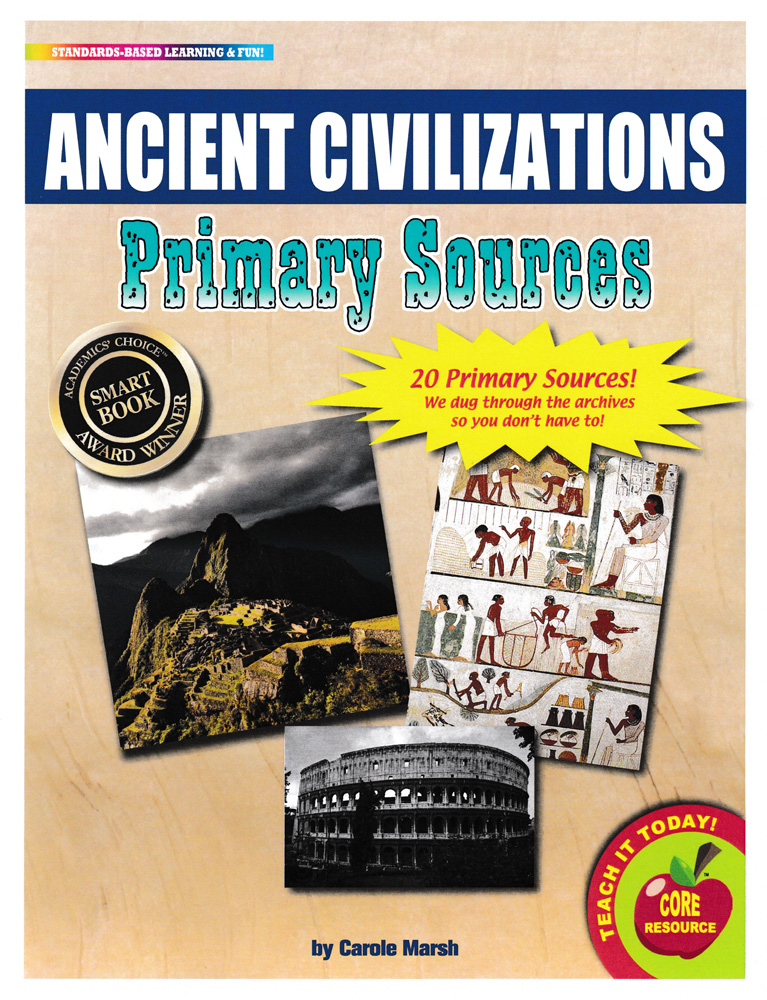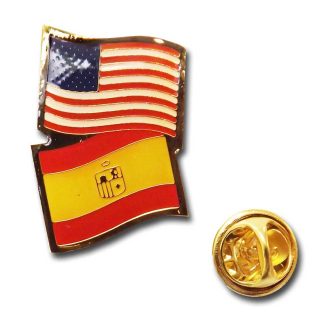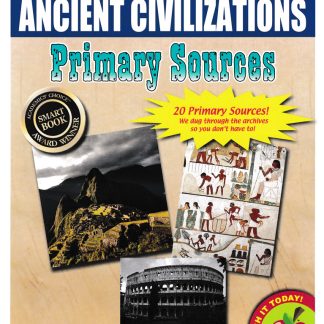Description
Ancient Civilization Primary Sources /emare just what teachers need to help students learn how to analyze primary sources in order to meet Common Core State Standards!Students participate in active learning by creating their own interpretations of history using historical documents. Students make observations, generate questions, organize information and ideas, think analytically, write persuasively or informatively, and cite evidence to support their opinions, hypotheses, and conclusions. Students learn how to integrate and evaluate information to deepen their understanding of historical events.The 20Ancient Civilization Primary Sources /emare: Photograph of ancient cuneiform writing in Ur, southern Iraq–the cuneiform system of writing was developed by ancient Sumerians of Mesopotamia circa 3500dash;3000 BCE Photograph of excavated ruins of Mohenjo-daro, city of the Indus Valley civilization that flourished between 3000 and 2000 BCE Examples from Babylonian King Hammurabi’s Code–his laws set up a universal system of justice for his empire dash; circa 1790 BCE. Ancient Egyptian agricultural scene from the Tomb of Nakht dash; circa 1500 BCE Photograph of Mykonos vase–one of the earliest known depictions of the Trojan Horse that Greeks used to enter Troy during Trojan War 11941184 BCE Portion of marble relief of Assyrian King Ashurbanipal–depicts military campaigns against Elam dash; between 668 and 627 BCE Statue of Siddhartha Gautama (;ldquo;the Buddha;rdquo;), on whose teachings Buddhism was founded dash;fourth-century BCE Photograph of the Parthenon in Athens, Greece–temple dedicated to the goddess Athena dash; construction began in 447 BC Photograph of Great Wall of China at Jinshanling–Great Wall was originally conceived in third century BCE by Emperor Qin Shi Huang Carving from the Alexander Sarcophagus showing Alexander the Great fighting Persians at the Battle of Issus in 333 BCE Photograph of Terracotta Army–sculptures of soldiers buried approximately 210 BCE with Qin Shi Huang, first Emperor of China Photograph of Roman aqueduct built approximately 1st century CE in Segovia, Spain Sculpture from the Arch of Titus in Rome depicting items taken from the Jewish temple after the Siege of Jerusalem in 70 CE dash; arch built 82 CE Photograph of the Roman Colosseum used for gladiatorial contests and public spectacles dash; construction completed in 80 CE Photograph of a stone ring representing a goal in the Maya Ball Court at Chich;eacute Itz;aacute;, Mexico dash; circa 600dash;900 CE Photograph of Machu Picchu–ancient Inca city built high in the Andes Mountains dash; city built approximately 1450 Map of Tenochtitl;aacute, capital city of the Aztec civilization–built on an island in Lake Texcoco dash; map created 1524 Image of Aztecs seeding, tilling, and harvesting maize from the Florentine Codex dash; circa 1540 Photograph of three men and a camel on the paw of the partially excavated Great Sphinx of Giza in Egypt dash; circa 1878 Photograph of Egyptologist Howard Carter examining the tomb of King Tut dash; 1923Your students will: Think critically and analytically, interpret events, and question various perspectives of history. Participate in active learning by creating their own interpretations instead of memorizing facts and a writer’s interpretations. Integrate and evaluate information provided in diverse media formats to deepen their understanding of historical events. Create a more relevant and meaningful learning experience.span style=”color:#FF0000;”Download the Gallopade Free Online Teacher;#39;s Guide for Primary Sources PDF located in “Additional Info.”/spanAll levels. 8 x 11 inches each. Cardstock.



